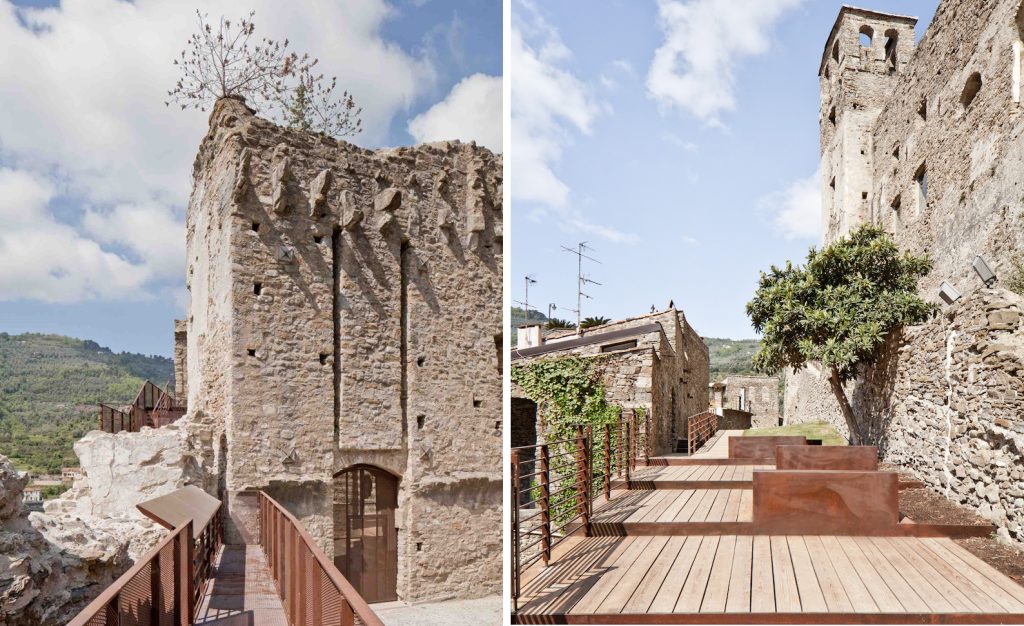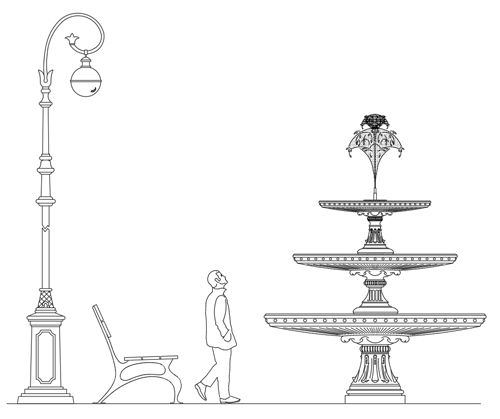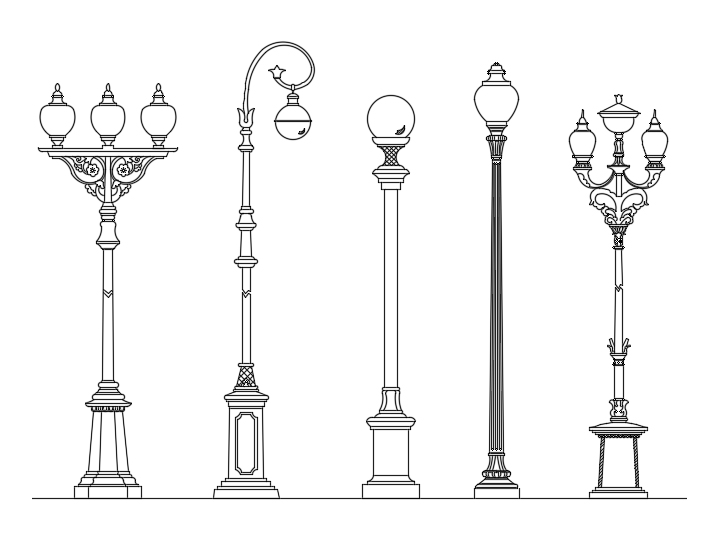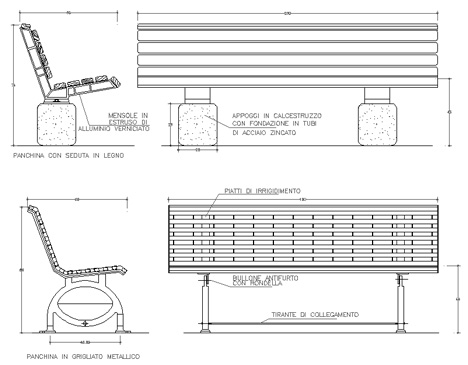Street furniture
Solutions for smart cities
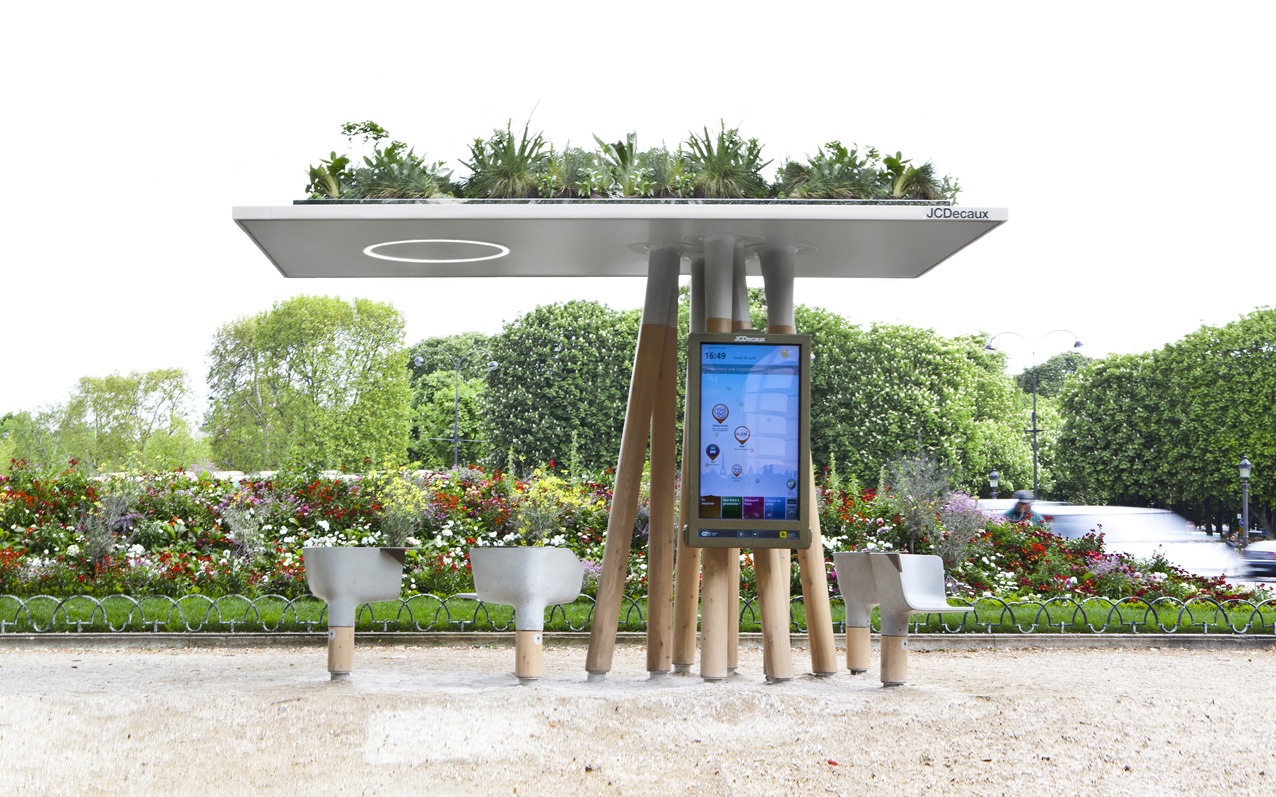
By “urban furniture management”, we mean the design sector that concerns the insertion, within the city scenario, of mobile or fixed furnishings aimed at the correct use of the common space. This is a very important aspect that embraces numerous issues including that of public lighting, equipment and the setting up of green areas. All the artifacts affixed to favor the correct flow of users are also part of this field, such as road signs and traffic bollards and pedestrian and car access.
This matter is governed by the Regulations for urban furniture and decor, which every municipality must be equipped with. This urban planning tool will not only establish the provisions regarding the minimum distances to be respected and the position of the furniture, but will ensure the decorum and healthiness of the urban space. To date, the Italian legislation appears to be fragmented and each Region adopts specific provisions studied on the conformation of the territory, on the cultural characteristics and on social needs. Sometimes, there may also be differences at the municipal level. However, some rules are valid at the national level: these are the UNI standards relating to public lighting systems and seats inserted within collective spaces. Furthermore, the current legislation has undergone a partial revision, introducing particular measures with a view to environmental sustainability and energy efficiency.
Urban furniture is now considered a crucial issue in the debate on smart cities, smart cities that exploit technological progress to provide more efficient services to citizens. In this sense, road signs and furnishing components become an integral and interactive part of that process aimed at facilitating the connection between the user and the living spaces.
In fact, the open environment with its components must be conceived as a living and dynamic organism capable of molding itself on the ever-changing needs of its users.
CAM and street furniture
We have often heard about CAMs and how such minimal environmental criteria are increasingly needed in the design sector. In the specific case of street furniture, reference is made to the Ministerial Decree of 5 February 2015 which introduced the obligation to comply with specific requirements aimed at promoting healthiness and respect for the environment within the urban scenario. In fact, in favor of a circular economy that knows how to make good use of resources and is able to avoid unnecessary waste and pollution, it is forbidden to use materials and finishes that are toxic or that can damage the environment and personal safety.
Urban furniture and technological progress
With the introduction of the concept of “smart city”, today urban scenarios take on particular importance and the artefacts that characterize them are designed to ensure a better quality of life for citizens. Thanks to technological innovation, in fact, street furniture helps to give a new face to cities and to restore the sense of belonging to the place where you live.
The concept behind integrated design is connectedness. By optimizing the resources available, it is possible to provide services that allow citizens to feel safer, more informed and active in the development process of the urban environment. To give a practical example, video surveillance systems can now be integrated with street furniture and at the same time can communicate 24 hours a day with the relevant operations centers, able to intervene promptly in the event of particular dangerous situations. Even the numerous interactive displays present in many cities, in correspondence with high-flow arteries or collective spaces, are designed to inform and make the user aware of what happens in the streets and in the city squares.
Another aspect that affects the design of the public space and the artefacts that compose it, concerns lighting. Very often we see real urban gaps and areas that are little used by users; these are spaces that for aesthetic or safety reasons do not reach the potential they have and remain deserted. One of the first causes is precisely the light: in the absence of adequate brightness at night, there is the desertification of areas perceived as dangerous for one’s own safety. Parks are a concrete example, very busy during the day and empty in the evening. To overcome this type of problem, for example, light devices equipped with presence sensors are used, capable of adjusting the light intensity according to the number of users encountered. The motto “the more we are, the more we illuminate” makes it clear the idea of also promoting socialization and attendance in public areas that could be used for events and exhibitions in the summer. This solution also guarantees considerable savings in energy and consequently economic terms.
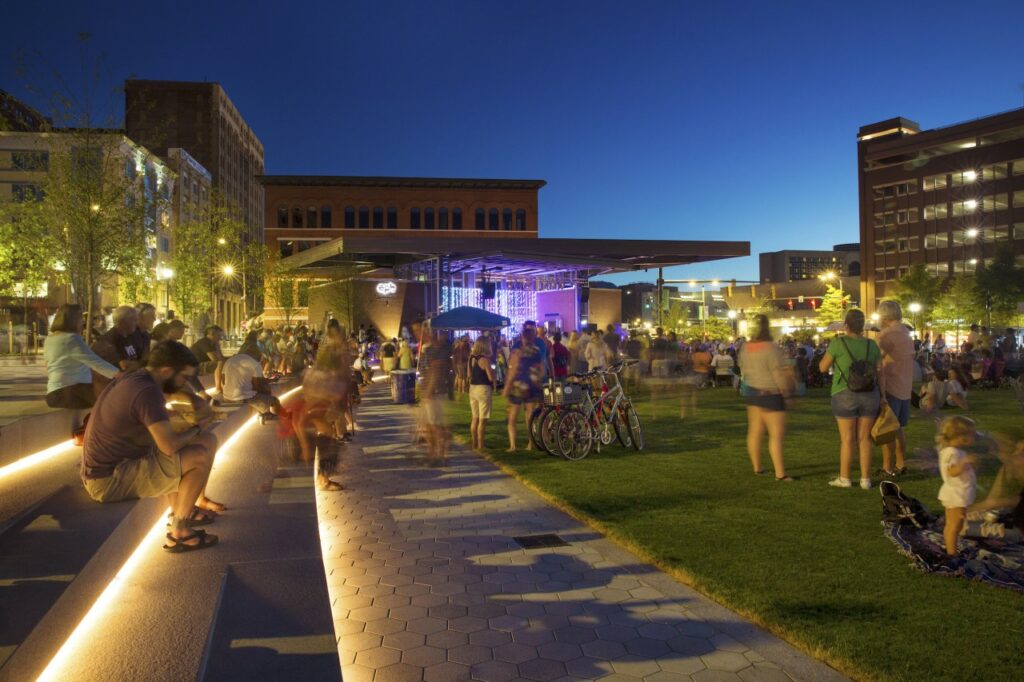
To view the drawings of the street lamps category for public lighting click here
Urban furniture and sustainability
The growing progress in terms of sustainability applied to the urban environment guarantees the use of solutions designed for energy saving. These are measures also applied to street furniture, which are able to exploit renewable resources and in some cases produce energy. In fact, more and more photovoltaic panels and films are integrated into bus shelters, seats in parks and even information totems. These elements are designed to convert the energy from the sun’s rays into useful energy to power the lighting of the shelters or the charging systems for mobile devices.
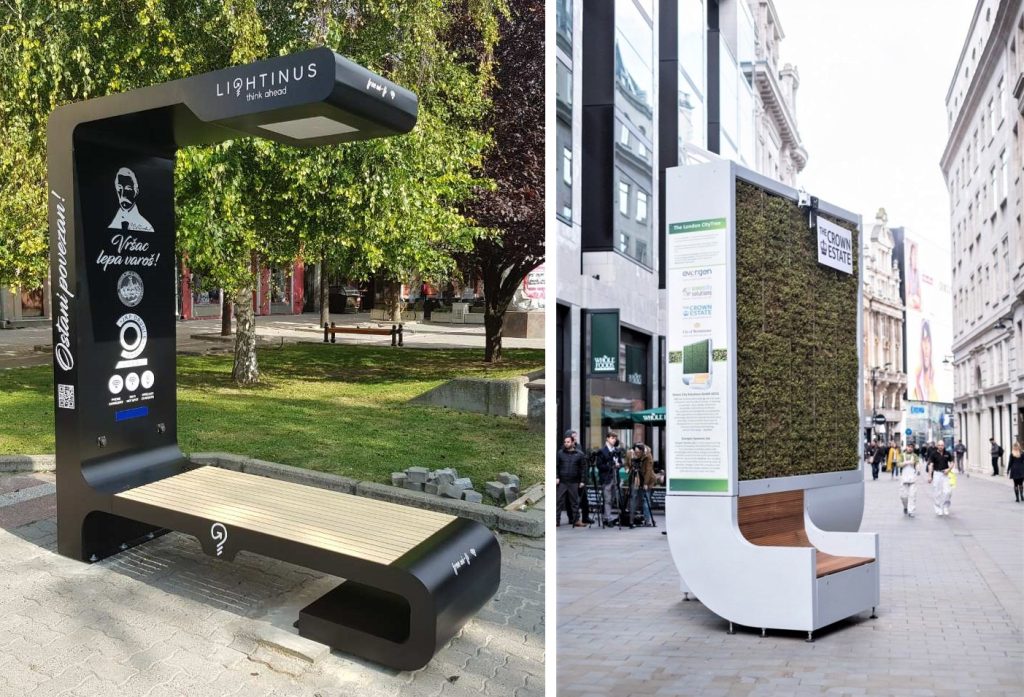
On the right: seat equipped with green inserts capable of purifying the air inside the city streets
Mobility is also interpreted in a “green” key, through solutions that encourage the use of alternative means such as bicycles and electric cars. Today the city streets are home to more and more charging stations for electric cars and bike racks. Both elements will be equipped with interactive and multifunctional systems, capable of powering the vehicles, providing for the necessary stall and providing additional services such as info points, medical assistance and SOS station for personal safety. In this way, in addition to improving the management and use of urban arteries, thanks to the reporting of traffic congestion or work in progress, the experience of the citizen who is the main user is optimized. In addition, there is a considerable decrease in harmful CO2 emissions caused by the excessive use of classic vehicles, resulting in a higher quality of air and health of citizens.
From an environmental point of view, it should be noted that the marked improvement in air quality is accompanied by the increase in public green areas. In this regard, the demand for urban spaces intended for parks and gardens that can be used by the community is growing. It is therefore considered necessary to properly design these areas, complemented by the inclusion of environmentally friendly and aesthetically pleasing furniture. For example, sports areas are sometimes set up inside urban parks where the citizen can help power the lighting system of the avenues which is essential during the night. In fact, through physical activity, the energy necessary for public street lamps is produced to diffuse the light. The presence of interactive totems allows the user to be informed about the quantification of his activity from an energy point of view. In this way the citizen becomes an integral part of the territorial system and concretely contributes to its correct functioning.
It is therefore clear that there is an increasing focus on the optimization of renewable resources within the urban scenario, with a view to making use of increasingly efficient collective spaces.
Urban furniture and redevelopment
Unfortunately, the furnishing components that occupy the streets, squares and city parks are often considered ancillary and negligible elements within the city. This consideration is caused by the unawareness of how much seating, waste collection baskets, bike racks, street lamps, play and sports equipment are essential for the proper livability of the area. The concrete demonstration of this concept is represented by the redevelopment projects of entire urban lots. In fact, in order to create healthy, functional areas and able to increase sociability, it is essential to include equipped areas that favor exchange and meeting.
It is good to remember how a place without meeting areas, equipped with seats and equipment, represents a non-place, a real urban void reluctantly frequented by people. The redevelopment of the same area in which elements of vegetation and furniture are inserted, will lead to the recovery of a sense of community, an increase in user flows and greater safety for the citizen. In some cases, previously neglected and marginal areas become new attraction poles which, in addition to benefiting the user, are a potential socio-economic driving force for the entire neighborhood.
Let’s see how some examples made become concrete expressions of what has been said.
Kic Park – Shanghai, China – Francesco Gatti – 2009
The ambitious redevelopment project of a space considered residual, in the new university area within the city of Shanghai, led to the construction of a small park inserted in the dense urban fabric. The lot has taken on a strong and recognizable identity thanks to the presence of a wooden stalls which, through fluid plastic movements, become urban furniture and green spaces. The natural material communicates closely with the sections of vegetation, rare in a city where overbuilding has taken over. In this case, the furniture in addition to fulfilling its function, restores identity to an otherwise neglected area, recreating a space for meeting and dialogue between people.
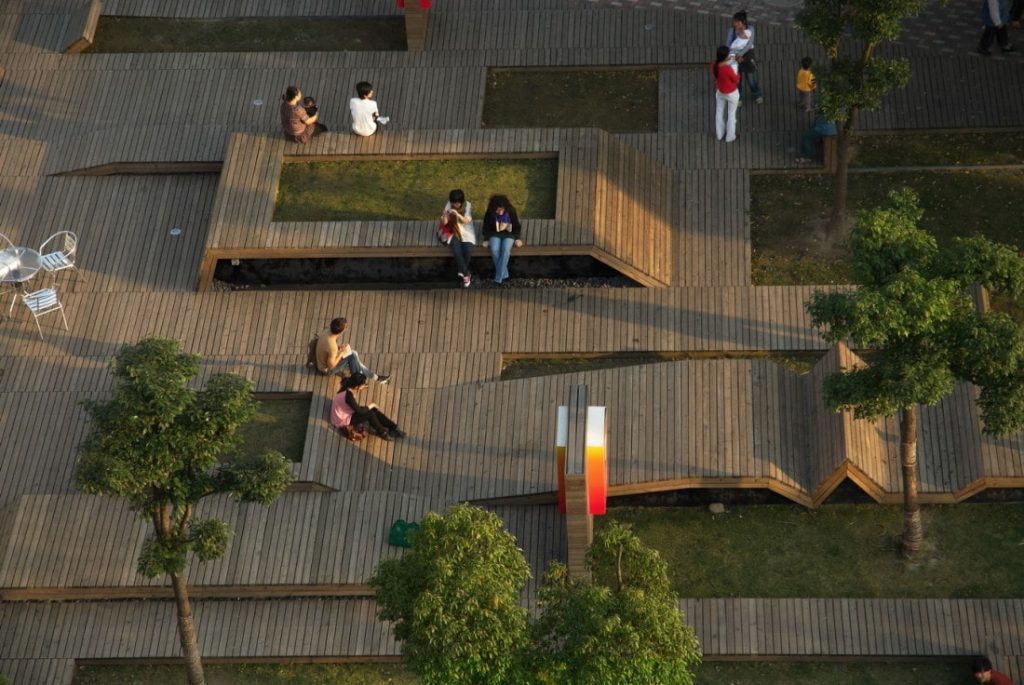
Doria Castle – Dolceacqua (Imperia) – LDA + SR – 2015
The recovery of the ancient Castle of Dolceacqua has included a redevelopment project for the entire area, aimed at improving the relationship between the building and the context in which it is inserted. To this end, an area intended for a public garden has been inserted at the foot of the castle, within which some seats have been inserted to encourage sociability and the recovery of the previously abandoned area. Urban furniture is here the protagonist of the enhancement of the lot and favors the usability of the areas surrounding the castle, increasing the flow of tourists and local inhabitants.
